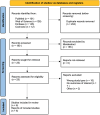Asprosin Levels in Adults with Type 2 Diabetes Mellitus and Diabetic Kidney Disease: A Systematic Review and Meta-Analysis
- PMID: 40726503
- PMCID: PMC12301137
- DOI: 10.2147/DMSO.S527579
Asprosin Levels in Adults with Type 2 Diabetes Mellitus and Diabetic Kidney Disease: A Systematic Review and Meta-Analysis
Abstract
Purpose: Diabetic kidney disease (DKD) significantly affects health and healthcare costs due to chronic kidney disease complications. Given asprosin's potential as a biomarker for disease progression, we conducted the first systematic review and meta-analysis on its relationship with DKD in adults with type 2 diabetes mellitus (T2DM).
Methods: PubMed, Embase, Cochrane, and Web of Science were systematically searched. Standard mean differences (SMD) with 95% confidence intervals (CI) and Fisher's Z transformation were used to examine the relationship between asprosin and DKD. The risk of bias was evaluated using the Newcastle-Ottawa Scale (NOS) and its version for cross-sectional studies. Heterogeneity (I² > 50%) was analyzed with a random-effects model.
Results: Six studies (n = 1340) were included. Meta-analysis results indicated that T2DM patients with DKD (micro/macroalbuminuria) had significantly higher circulating asprosin levels than normoalbuminuric T2DM patients (SMD: 1.5, 95% CI: 0.69-2.32, p = 0.0003). Meta-analysis of correlation revealed a positive association of asprosin with urinary albumin excretion ratio (UACR) (Fisher's Z = 0.4; 95% CI: 0.240-0.554, p < 0.001) and body mass index (BMI) (Fisher's Z = 0.17; 95% CI: 0.036-0.301, p = 0.013), and a negative association with estimated glomerular filtration rate (eGFR) (Fisher's Z = -0.35; 95% CI: -0.471 to -0.239, p < 0.001).
Conclusion: Asprosin is elevated in T2DM patients with pre-DKD (early stage DKD) and DKD and correlates with key markers of disease severity. Additional research is required to better understand the pathophysiological mechanisms of asprosin and its role in DKD.
Keywords: adipokine; albuminuria; asprosin; diabetes mellitus; diabetic kidney disease; eGFR.
© 2025 Ristic et al.
Conflict of interest statement
The authors report no conflicts of interest in this work.
Figures










Similar articles
-
Vitamin B and its derivatives for diabetic kidney disease.Cochrane Database Syst Rev. 2015 Jan 12;1(1):CD009403. doi: 10.1002/14651858.CD009403.pub2. Cochrane Database Syst Rev. 2015. PMID: 25579852 Free PMC article.
-
Multidisciplinary management of diabetic kidney disease: a systematic review and meta-analysis.JBI Database System Rev Implement Rep. 2016 Jul;14(7):169-207. doi: 10.11124/JBISRIR-2016-003011. JBI Database System Rev Implement Rep. 2016. PMID: 27532796
-
Pentoxifylline for diabetic kidney disease.Cochrane Database Syst Rev. 2012 Feb 15;2012(2):CD006800. doi: 10.1002/14651858.CD006800.pub2. Cochrane Database Syst Rev. 2012. PMID: 22336824 Free PMC article.
-
Protein restriction for diabetic kidney disease.Cochrane Database Syst Rev. 2023 Jan 3;1(1):CD014906. doi: 10.1002/14651858.CD014906.pub2. Cochrane Database Syst Rev. 2023. PMID: 36594428 Free PMC article.
-
Chinese herbal medicine (Tangshen Formula) formula treatment of patients with diabetic kidney disease: a systematic review and meta-analysis.Front Endocrinol (Lausanne). 2025 Jun 16;16:1522759. doi: 10.3389/fendo.2025.1522759. eCollection 2025. Front Endocrinol (Lausanne). 2025. PMID: 40589511 Free PMC article.
References
-
- Liu B, Li L, Cui H, et al. Analysis of the global burden of CKD-T2DM in young and middle-aged adults in 204 countries and territories from 2000 to 2019: a systematic study of the global burden of disease in 2019. Diabet Res Clin Pract. 2024;217:111884. doi: 10.1016/j.diabres.2024.111884 - DOI - PubMed
Publication types
LinkOut - more resources
Full Text Sources
Research Materials
Miscellaneous

